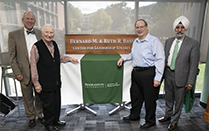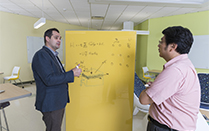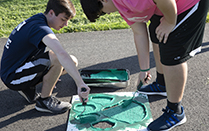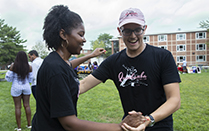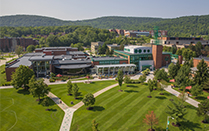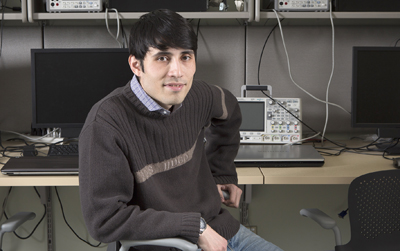
Student aims to improve wireless technology
A Binghamton University undergraduate is part of a team working to solve problems caused by the increase in wireless technology.
Devices like cell phones and wireless printers compete to communicate within a finite spectrum, accessing different portions in order to transmit data. In the same way that overlapping radio frequencies can sound fuzzy and unclear, when these wireless signals overlap, none of them can communicate efficiently.
Azizjon “Isaac” Saliev, a senior electrical engineering major, says his goal is to ensure clear communication by using specific frequency ranges more efficiently. The problem is that the rise in wireless technology happened so quickly, that the frequency spectrum that had been thought to be inexhaustible became scarce. That’s pushing engineers to create better algorithms, methods and techniques of wireless data transmission.
“This field of study is relatively new,” Saliev says. “We used to think we had an unlimited amount of frequency domain.”
Saliev and his colleagues are trying to solve this problem by using cognitive radio networks (CRNs). These CRNs will automatically detect the available network, and transmit their signal using the available unoccupied space, rather than overlapping with other signals. His approach is to create an algorithm to detect the specific frequencies that devices are signaling. This information would be helpful when applied to emergency communications, where the efficiency of a radio signal could mean the difference between life and death.
Saliev left Uzbekistan five years ago to pursue an education at Binghamton. Today he’s such a dedicated student that his biggest fear about a recent snowstorm was that it would keep him from his linear algebra class. He is one of the first students at Binghamton to work on this project, sponsored by a three-year grant from the National Science Foundation and headed by Xiaohua Li, an associate professor of electrical and computer engineering.
Li says it was a combination of Saliev’s class rank, previous research experience and ambition that made him the ideal candidate for this project. That ambition goes a long way in Li’s lab, where he called on Saliev and his partner to create the test bed for the experiment. “I asked them to set up a communication system using cognitive radio devices,” Li says.
Saliev and his partner had to complete extensive Internet research and make their own software, developing a test bed that allowed the project to proceed.
In addition to the work he is doing in Binghamton, Saliev spent a summer in Taiwan, where he conducted research for Microsoft’s Xbox Kinect. He developed two simple games in which the players use their bodies to control the on-screen movement.
Saliev plans to seek a doctorate in electrical engineering after he graduates, and he already has a job as an integration engineer at IBM starting this summer.
“In the long run,” he says, “I want to be an entrepreneur, and maybe open up my own start-up or consulting firm for the technology industry. My ultimate goal is to share my knowledge with others and make the world little better than it is today.”


